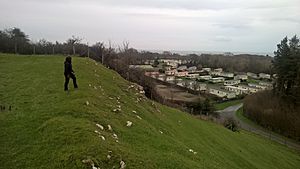Parciau hill fort facts for kids
Parciau hill fort is an ancient fort built on a hill, located on the Welsh island of Anglesey. It sits on top of a hill called Bryn Ddiôl. This Welsh name means "trackless hill," which tells us it was a hard place to reach!
Contents
Exploring Parciau Hill Fort
What is Parciau Hill Fort?
Parciau hill fort is built on a flat-topped hill called Bryn Ddiôl. This hill is about 95 metres (312 feet) above sea level. It's made of a type of rock called Carboniferous Limestone.
The fort was naturally protected on three sides by steep cliffs and slopes. Today, there are also modern caravan sites and buildings around it. The fort is about 2 kilometres (1.2 miles) from the beaches on the northwest coast of Anglesey. From here, you can see amazing views of the sea!
To the west, the hill slopes gently, making it easier to get in. Here, the fort had at least one outer wall. You can still see where the entrance was, next to a small gate-house. The wall goes all the way around the hill, protecting an area about 110 metres (360 feet) long and 80 metres (260 feet) wide.
What Did Aerial Photos Show?
Special photos taken from above (aerial photography) have shown interesting things inside the fort. They revealed marks on the ground where about 28 stone hut circles once stood. These huts were packed closely together, and each one was about 7.5 to 8.2 metres (24 to 27 feet) across.
Parciau hill fort is very important, so it is officially protected as a Scheduled monument. This means it's a special historical site.
Life in the Roman Period
What Was Found at the Fort?
Archaeologists have dug at Parciau hill fort several times. In 1867, a person named Prichard found some interesting things inside one of the hut circles. The floor of the hut had seashells, bones from farm animals, charcoal, and pieces of pottery. Some of the pottery was a special type called "Samian ware," which was common in Roman times. They also found tiny coloured glass beads and small pieces of bronze.
Later, in 1923, Edward Neil Baynes also dug at the site. He found a small collection of Roman coins. These coins were from different Roman emperors who lived between 253 AD and 326 AD.
Baynes also found more animal bones, including horse bones. Other items included pieces of Roman pottery, a Roman glass fragment, and an iron nail. He even found a small bowl made of red sandstone and a shaped stone.
Did Romans Live Here?
Some clues suggest that a Roman building might have been nearby. Baynes found pieces of "box tiles." These tiles were used in a Roman heating system called a hypocaust, which warmed houses from underneath. This suggests a comfortable Roman home might have been close to the fort.
Another report from Prichard mentioned "well-built walls" found near Parciau farmhouse, which is southwest of the fort. One of these walls even had a human skeleton inside! This could mean there was a rich Roman building there. However, some people thought these walls were from a much later time, around the 1600s.
Gallery






